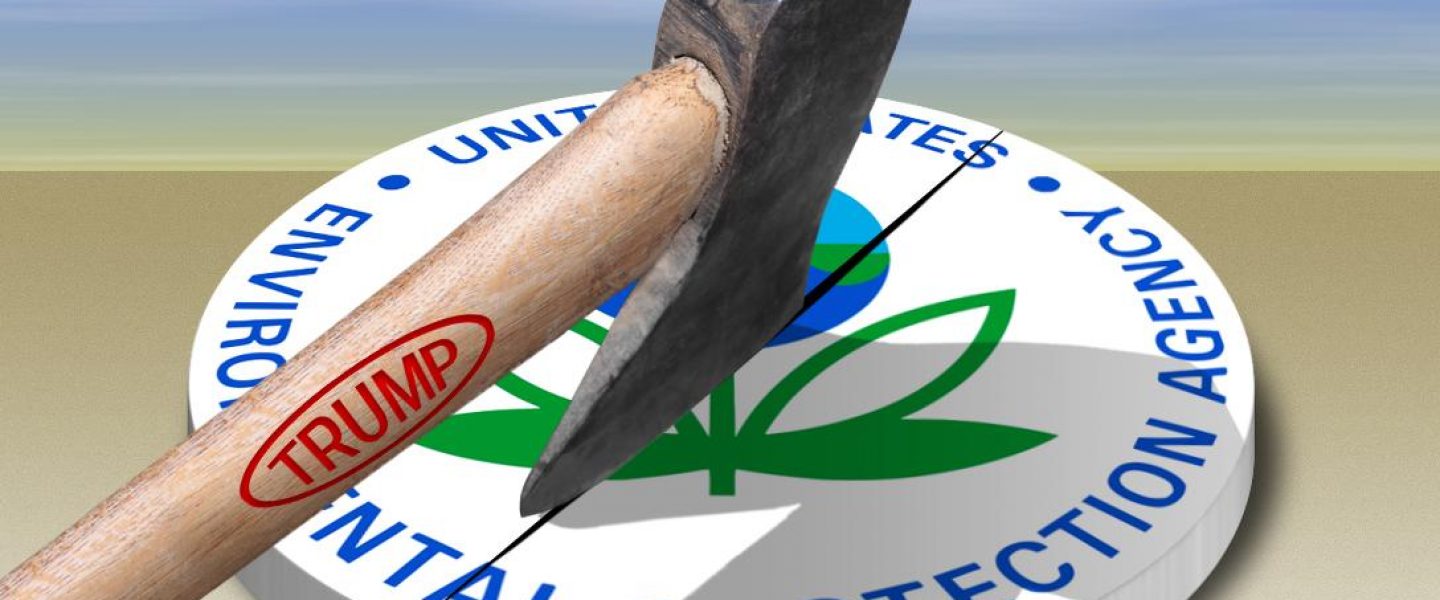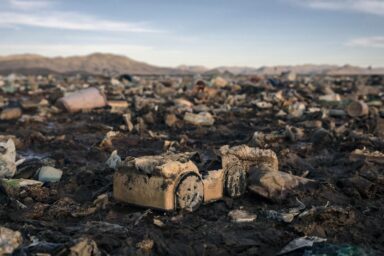Can the EPA Survive Trump & Congress?
Profile of an Agency in Crisis Through the Eyes of a Former EPA Official
With draconian budget cuts, behavior causing committed staff to leave, and the passage of laws that would make it impossible for an agency to function under any administration, are Trump and Congress trying to destroy the Environmental Protection Agency?
In the first few days of the Trump administration, the Environmental Protection Agency (EPA) already has felt shockwaves.
Trump issued an Executive Order imposing an immediate hiring freeze on federal agencies for 90 days, giving the Office of Personnel Management time to come up with a plan to shrink the federal government through attrition. At a time when the federal workforce includes many workers about to retire, the impact could be substantial.
The new administration has informed the EPA and other science agencies that its scientists may no longer publish or speak publicly about their research without a review by the White House. Agency staff also may not post blogs or comments on social media.
The nominee to head the EPA, Oklahoma Attorney General Scott Pruitt, is an avowed enemy of the agency and has sued it 14 times to block enforcement of its rules. Questioned about human-caused climate change, Pruitt grudgingly conceded its existence. But he said that the extent of its harmful effects had not been adequately assessed and is “subject to continuing debate.”
No wonder that David Doniger, director and senior attorney for the Natural Resources Defense Council’s climate and clean air program, predicts, “[The environmental community is] in for a rough ride.”
Doniger joined NRDC in 1978, and in 1993 took a position in the Clinton administration. He spent most of his time there as counsel to the head of the EPA’s clean air program and director of climate change policy for the agency’s air program. He also represented the US during climate negotiations in Kyoto. He returned to NRDC in 2001. He sat down for an interview with WhoWhatWhy on January 24.
Doniger knows what it’s like to face political opposition to environmental policies from Republican and Democratic members of Congress looking to protect fossil fuel industries. He’s seen Ronald Reagan, Newt Gingrich and George W. Bush try to dismantle the EPA.
“This is different,” he says.
The tactics may not have changed, but the intensity is far greater.
He worries that the Trump administration’s goal is not simply to reverse specific Obama Administration policies, but to destroy the agency and the laws it implements more fundamentally — through draconian budget cuts, the departures of committed staff, and the passage of laws that would make it impossible for the agency to do its work under any administration.
At stake, he says, is the agency’s long-term future.

Tall and lean, Doniger is bald and bearded, with a sardonic wit. His work space is small, part of a suite of offices occupying the entire floor of a modern skyscraper in Washington a few blocks from the Washington Monument. The building’s mix of tenants is diverse. Coal industry lobbyists used to rent offices upstairs, Doniger says. The building continues to house The Weekly Standard, Bill Kristol’s conservative publication.
NRDC reports that it has 2.4 million members and activists. Its annual budget tops $130 million. It isn’t that NRDC and its environmental allies lack a game plan. They know that “you don’t get anywhere just with information anymore,” Doniger says.
NRDC bases its work on facts, science, and “true stuff,” but what makes that information effective is conveying a message to either “embolden” friendly members of Congress, or “scare” the unfriendly ones, into doing the right thing, he says. Pressure on Congress and the new administration requires mobilizing large numbers of citizens, he says, an effort that began in earnest with the Women’s March on Washington on January 21. NRDC was one of the co-sponsors of the event.
Doniger believes in the rule of law and the rule of the marketplace. He has predicted that the courts will continue to uphold the EPA’s authority and obligation to protect public health from the harmful effects of climate change. That means the agency will be able to continue to regulate carbon pollution from power plants, cars and trucks and other polluting industries. As for the marketplace, electric utilities already have moved away from building any new coal-fired power plants, and there is growing reliance on other sources of energy, such as natural gas, solar, wind and even nuclear power.
Polls also have offered some reason for hope. When the D.C.-based Glover Park Group, a lobbying and strategic communications firm, did an online survey of 2,000 Trump voters last December, they expressed strong support for regulations protecting air and water. Even policies to address climate change were backed by six out of ten Trump voters.
However, a Pew Research Center post-election poll was less sanguine. While a majority of Americans support environmental regulations, saying they are worth the cost, the support was much more robust among Democrats, Independents and moderate Republicans. Fewer than a third of conservative Republicans agreed.
And other concerns darken the horizon.

What’s at stake, Doniger says, is whether there will still be an EPA strong enough to rebound when a more environmentally friendly Congress or White House takes over.
The EPA is built on foundational laws such as the Clean Air Act and the Clean Water Act. They essentially give the agency the power to develop rules and enforce them to protect public health threatened by tainted air and water.
According to its website, the agency’s mission is “to ensure that all Americans are protected from significant risks to human health and the environment where they live, learn and work,” to base its actions on the “best available scientific information,” and to enforce federal laws protecting human health and environment “fairly and effectively.”
The agency’s birth in 1970 came at a time when Americans were alarmed by smog and burning rivers, when Rachel Carson’s Silent Spring had raised concerns about toxic chemicals and their potential risks.
In 1965, President Lyndon Johnson asked for passage of the Clean Air and Clean Water Acts.
“His message to Congress listed all the problems the laws should address,” Doniger says. Johnson directly asked for “authority to address carbon emissions” because of the “risk of global warming.”
Doniger calls Senators Edmund Muskie (D-ME) and Howard Baker (R-TN) the laws’ “founding fathers.” They and their staffs, he says, were “extremely far-sighted” in their understanding of what was needed to protect public health and the environment, and to address “new problems as they arise.”
The laws were designed to insulate the EPA from being “captured” by the industries they regulated, he adds. Not only could business interests sue the agency if they felt its rules were too stringent, so could environmental groups if they believed the agency was not meeting the timetables in the law or enforcing it properly.
That meant that groups like NRDC could take the EPA to court, he says.
He concedes that neither law would pass today, but in the 1970s, they were approved “almost unanimously” by Congress. Indeed, President Richard Nixon’s leadership was crucial to the creation of the EPA.
There have been past administrations hostile to the EPA before, but the political calculus has been different. “Even in the Reagan days, there was still more bipartisan support” for environmental protection, Doniger says.
In the 1980s, for example, when Anne Gorsuch was named EPA Administrator, her tenure lasted only 22 months. Gorsuch attempted to eviscerate the Clean Air Act. But she was challenged by a Democratic House, and moderate, pro-environment Republicans in the Senate.
Gorsuch, he says, was an extremist, “probably Koch Brothers before there was the Koch Brothers.” But she and her deputies “overreached” and “got booted out.”

House Democrats held hearings, and pointed a spotlight on a leaked EPA “hit list” of staffers, including scientists, targeted by Gorsuch and her lieutenants. There were charges of mismanagement in EPA’s toxic waste programs. The investigations resulted in a short tenure for Reagan’s appointees. With one exception, Doniger says, Gorsuch and all her deputies were forced to resign. (Doniger notes with irony that Gorsuch’s son, Neil, was on Trump’s short list for the Supreme Court. He was nominated for the court on Jan. 31)
Faced with congressional resistance and a public outcry, Reagan replaced Gorsuch with William Ruckelshaus, who had served as the EPA’s first administrator under Nixon. Republican Ruckelshaus is credited with restoring morale at the agency, and beefing up its enforcement efforts. When he left his position, he wrote to Reagan that ”The ship called EPA is righted and is now steering a steady course.”
EPA also endured the fierce budget cutting of the Gingrich Revolution, when Republican conservatives took over the House in 1994. But the backstop was Democratic President Bill Clinton. Clinton resisted Gingrich’s efforts to gut EPA regulations, and vetoed spending bills that would have imposed huge cuts on the EPA and other federal agencies. That budget stalemate resulted in a federal government shutdown and an ultimate political win for the president.
While President George H.W. Bush actually helped pass 1990 legislation strengthening the Clean Air Act, President George W. Bush and Vice President Dick Cheney wanted to reverse progress. But nothing Bush and Cheney tried to do to weaken the EPA was as extreme as the Trump proposals, Doniger says. “The worst shading of the truth in the George W. years already has been exceeded” by the Trump administration, he charges.
It is no longer only the business lobby that opposes the EPA, Doniger says, adding that the “emergence of the far right” has bolstered forces against the agency. These forces, he adds, “have effectively taken over one party.” The new president, he insists, has himself been taken over “by [the conservative Heritage Foundation] and the Koch brothers. Suddenly the fringe is in the center.”

Doniger knows the EPA both as an advocate who pushed it do more, as well as a staffer who worked from within. He respects its career staff. He calls them “very smart, very strategic,” and committed to environmental protection.
The message of the new administration has “disheartened” staffers, he says. But many staffers, he adds, want to stay and “weather this.”
But it could be far more difficult. Environmental advocates are depending on Senate Democrats to use the filibuster — ensuring that the Republican’s slim 52-48 majority will not be enough to pass most legislation — to defend the agency. But the threats on the EPA are more intense. Even in the George W. Bush years, Doniger says, “the constraints and restraints were not so absolute” that they prevented the agency from functioning.
He recalls his own work in the Clinton EPA, which laid the groundwork for an agency legal opinion establishing the EPA’s authority to regulate greenhouse gas emissions, if those emissions contribute to climate change and harm public health.
When the George W. Bush administration reversed that legal opinion and refused to regulate carbon emissions and other air pollutants, Doniger, then back at NRDC, sued the agency. The case, Massachusetts vs. EPA, went all the way to the Supreme Court. The court ruled, Doniger says, that the original EPA legal opinion was right, and “the Bush Administration had the wrong view of the law.”
The Bush White House dragged its feet in implementing the court’s ruling, and blocked moving the ball forward on addressing climate change. Nevertheless, EPA administrator Stephen Johnson asked agency staff to develop the evidence that proved that climate change endangered human health. When the EPA emailed its endangerment finding to Bush’s Office of Management and Budget (OMB), officials there refused to open the email attachment, and kept the document secret.
However, when Obama came into office, Doniger says, “the EPA had done its homework.” The endangerment finding was ready. It helped the Obama EPA defend its actions to limit emissions of carbon dioxide and other greenhouse gases contributing to climate change. The rules Obama’s EPA implemented have been upheld by the courts.
“The people on the other side know this story,” Doniger says. That’s why “they are determined to destroy the agency’s capacity,” he charges. It’s a “scorched earth” tactic, he says, similar to an invading army’s destroying roads and bridges so that the enemy can’t easily rebuild.
How do you destroy an agency so thoroughly that it can’t revive, even when the politics change?
If budget cuts are draconian enough, the EPA will lack the experts it needs to do its work. “Smart people will leave,” he says. He fears a “massive brain drain” at the agency. That affects not only the agency’s ability to use science to regulate but also to justify its regulations by demonstrating that the cost of compliance is outweighed by the benefits to the public and the environment.

Doniger doubts that even the Trump administration and Congress would try to gut the Clean Air and Clean Water Acts directly, since they remain politically popular with all voters, including Trump supporters.
But Congress could pass “sneaky regulatory bills” that will overturn these and other fundamental laws in other ways. He cites the REINS (Regulations from the Executive in Need of Scrutiny) Act that essentially treats any agency regulation as if it were just a proposed law, needing approval by Congress within a tight timeframe. Other regulatory bills would “complicate the process, rigging the game,” so that agencies could not regulate, regardless of the risks to the public.
The Trump administration also could pull away from the Paris agreement on climate change, Doniger says. But doing so, he predicts, would cause outrage from virtually every other nation in the world, and greatly complicate US efforts to get cooperation in fighting terrorism or on trade. “You hope that Trump’s national security and foreign policy appointees get it,” he says.
He adds that if the US drops out, China “is in the position to claim leadership” on climate change. China recognizes its pollution problems, and also is encouraging its renewable energy industry. That would mean “a major loss of prestige” for the US.
These are Doniger’s macro fears. But there also are the worries closer to home, the issues on which he played a pivotal role. He recalls, for example, his informal chat in 2008 with an auto company lobbyist, worried that his company would have to comply not only with federal EPA greenhouse gas emissions and fuel efficiency standards, but also regulations from California and the Department of Transportation.
Doniger asked if the auto company would be willing to follow an EPA standard that was as stringent as California’s, provided that was the only standard its cars would have to meet. The lobbyist said that was a “good idea” but that “Mary Nichols [California’s air quality regulator] would never go for it.”
Doniger then approached Nichols with the same proposal. She was receptive, but told him, “GM will never go for it.” Doniger suggested they talk to one another.
These talks, begun in the waning days of the Bush administration, set the stage for the Obama team to forge an agreement. The 13 automakers would not oppose stricter federal emissions and fuel efficiency standards, and California would deem cars that met those standards to be in compliance with state rules.
That was a huge achievement, but “now that’s in peril,” he says. Automakers are pressing Trump to relax the EPA standards, and want the administration to force California to back down and accept them.
The EPA may try to revoke its permission to California to set higher emissions and fuel efficiency standards, he says. California, and a dozen other states will fight the EPA’s efforts.
“These are the things I think about,” Doniger says. “The terrible time ahead, but also the accomplishments,” over the years, and whether they will survive.
Related front page panorama photo credit: Adapted by WhoWhatWhy from Trump Golden Spiral (Christof H. / Flickr)



